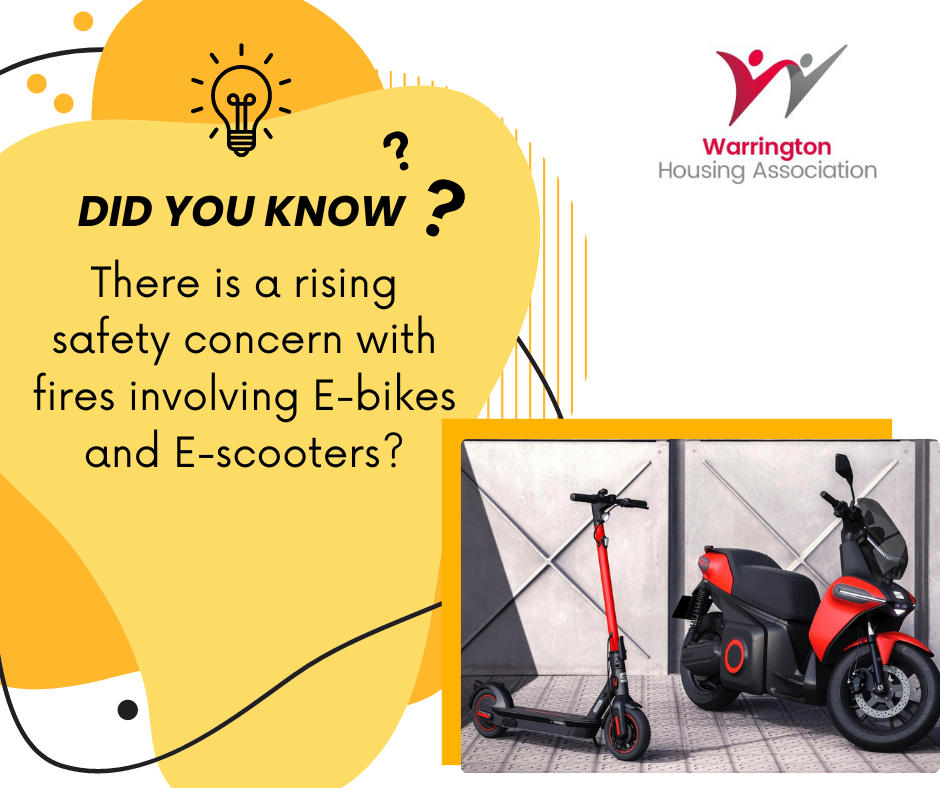
E-bikes and e-scooters fire safety guidance.
E-bikes and e-scooters are becoming increasingly popular. Most are powered by lithium-ion batteries which can be charged in the home. The use of these batteries in a wide range of household products is becoming increasingly common.
It is important when charging e-bikes and e-scooters, you do so safely to avoid a risk of a fire starting and putting your families and homes at risk.
With an increased use of e-bikes and e-scooters, comes a corresponding fire safety concern associated with their charging and storage. The use of these products is expected to continue to rise. Some fire services and fire investigators have seen a rise in e-bike and e-scooter battery fires.
On occasions batteries can fail catastrophically, they can ‘explode’ and/or lead to a rapidly developing fire.
The incorrect disposal of lithium-ion batteries in general household and recycling waste can lead to significant waste fires.
Key messages
The following messages can be useful in communicating the risk and minimising the risk of fire:
Charging
- Follow the manufacturer’s instructions when charging and always unplug your charger when it’s finished charging.
- Ensure you have working smoke alarms. If you charge or store your e-bike or e-scooter in a garage or kitchen ensure you install detection, we recommend heat alarms rather smoke detectors for these areas.
- Charge batteries whilst you are awake and alert so if a fire should occur you can respond quickly. Don’t leave batteries to charge while you are asleep or away from the home.
- Always use the manufacturer approved charger for the product, and if you spot any signs of wear and tear or damage buy an official replacement charger for your product from a reputable seller.
- Do not cover chargers or battery packs when charging as this could lead to overheating or even a fire.
- Do not charge batteries or store your e-bike or e-scooter near combustible or flammable materials.
- Do not overcharge your battery – check the manufacturer’s instructions for charge times.
- Do not overload socket outlets or use inappropriate extension leads (use un-coiled extensions and ensure the lead is suitably rated for what you are plugging in to it).
- In the event of an e-bike, e-scooter or lithium-ion battery fire – do not attempt to extinguish the fire. Get out, stay out, call 999.
Storage
- Avoid storing or charging e-bikes and e-scooters on escape routes or in communal areas of a multi occupied building. If there’s a fire, it can affect people’s ability to escape.
- Responsible Persons should consider the risks posed by e-bikes and e-scooters where they are charged or left in common areas such as means of escape, bike stores and mobility scooter charging rooms. They may wish to offer advice to residents on the safe use, storage and charging of these products.
- Store e-bikes and e-scooters and their batteries in a cool place. Avoid storing them in excessively hot or cold areas.
- Follow manufacturer’s instructions for the storage and maintenance of lithium -ion batteries if they are not going to be used for extended periods of time.
Buying
- Buy e-bikes, e-scooters and chargers and batteries from reputable retailers.
- Many fires involve counterfeit electrical goods. Items which don’t meet British or European standards pose a huge fire risk and while genuine chargers (or battery packs) may cost more, it’s not worth putting your life at risk and potentially destroying your home by buying a fake charger to save a few pounds.
- If buying an e-bike conversion kit, purchase from a reputable seller and check that it complies with British or European standards. Take particular care if buying from online auction or fulfilment platforms. Also be aware that if buying separate components, you should check that they are compatible.
- Register your product with the manufacturer to validate any warranties – batteries are usually included in warranties. Registering makes it easier for manufacturers to contact you in the event of safety or recall information.
- Check any products you have bought are not subject to a product recall. You can do this but checking Electrical Safety First’s website or the government website.
Damage and disposal
- Batteries can be damaged by dropping them or crashing e-bikes or e-scooters. Where the battery is damaged, it can overheat and catch fire without warning. Check your battery regularly for any signs of damage and if you suspect it is damaged it should be replaced and should not be used or charged.
- If you need to dispose of a damaged or end of life battery, don’t dispose of it in your household waste or normal recycling. These batteries, when punctured or crushed can cause fires in bin lorries, recycling and waste centres. Your e- bike or e- scooter manufacturer may offer a recycling service. Alternatively check with your local authority for suitable battery recycling arrangements in your area.
Enjoy and ride your e-bike or e-scooter safely and ensure you are using these products within the law. Further information can be found here https://www.gov.uk/electric-bike-rules and for e-scooters
Further information around lithium-ion batteries is available from NFCC via FRS Learn





